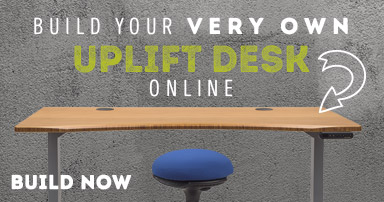Implement Office Ergonomics Before Health Problems Arise
Posted by Human Solution on Mar 20th 2013
Whether you work at home, in an industrial setting, or at a corporate office, there can be factors in the work environment that degrade your health and wellness and may lead to serious injuries. Troubleshooting these issues before they become major health problems is important as well as cost and time efficient. The trick is prioritizing office ergonomics in a way that works for your particular needs and budget.
This change doesn’t have to happen all at once. Awareness can be a huge step in making a big change in the workplace to benefit your health and comfort. Set the goal to increase mindfulness about workplace ergonomics, and down the road the solution to combating pain and health issues at work can be plotted when the problem becomes more salient.
Red Flags in the Office:
Knowing the warning signs to look for is essential in facilitating change to better your conditions at work. Early indicators affect productivity as well as overall health and well-being. Taking early action will ameliorate absenteeism and ease healthcare costs. Start by asking yourself if there are any issues in the workplace relating to your fatigue and discomfort. Subtle changes may not be noticed immediately, but if you focus for a moment on the issue or track it over time, you may have realizations or responses you did not expect. Be on the lookout for these red flags, culled from an "Easy Ergonomics" guide published by the Department of Industrial Relations at Cal/OSHA:
- Fatigue and discomfort, and the restriction of movement due to fatigue or discomfort
- You are modifying tools, equipment or work spaces because they cause you discomfort
- You miss a lot of work
- You notice issues in your quality of work or high rates of error
In thinking about these red flags as signaling wellness issues in the work environment, it’s also helpful to be aware of contributing factors, or ways people get hurt over time. Some of these are:
- Awkward positions and postures
- Repetitive Motions
- Forceful Exertions
- Pressure point discomfort (contact and angles of the body throughout the day)
In looking at these red flags and contributing factors, it’s very important to uncover the “why” of any workplace discomfort. For example, if you notice awkward body positions as you are working, is the task you are doing hindered by a table or desk that is not positioned properly? Is your chair not supporting your lower back or promoting good posture? Are you straining to read a document or computer screen? When you are able to start answering the “why,” you will start focusing on how a particular solution can remedy the issue.
Quick Tips for Improvement:
Don’t end the process just by becoming clearer on the problem. It may be tempting, but don’t do it! You’re halfway there! Below are some quick tips for improving the work environment after you’ve become clear on the what, why, and how of heath and comfort issues:
- Modify your work environment so equipment and frequently used office furniture can be adjustable
- Allow for comfortable and upright working posture that supports your body
- Find office furniture that fits your budget but that can also be adjusted to your body type
- Reposition your work so that bending, leaning, or awkward postures are avoided
Office accessories that can help with the issues listed above are foot rests, keyboard trays, ergonomic chairs, standing desks, and monitor arms.
If you'd like further assistance in understanding how to improve your work environment's ergonomics, feel free to call us at: 800-531-3746
Learn more about how to create an active, healthy ergonomic office at TheHumanSolution.com.




